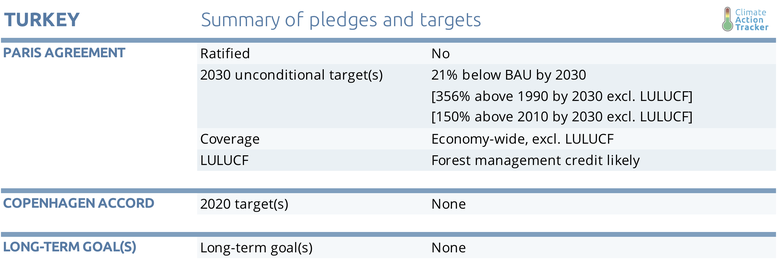Pledges And Targets
Summary table

Pledges and targets
Turkey submitted its INDC in 2015, with the aim of unconditionally reducing GHG emissions including LULUCF in 2030 by 21% below a BAU projection. The INDC submission provides the reference BAU projection (1175 MtCO2e, GWP AR4, including LULUCF) and indicates that the target emissions level is 929 MtCO2e (incl. LULUCF, based on GWP from AR4) in 2030 (The Republic of Turkey, 2015). Since we exclude LULUCF emissions in our rating methodology, we have excluded the LULUCFs emissions projected in 2030 from the “with measures scenario” in the 7th national communication, strictly equivalent to the INDC. The INDC target in 2030 equals 999 MtCO2e, excluding LULUCF emissions.
Turkey remains the only G20 country that has not yet ratified the Paris Agreement. Turkey is hoping for a differentiated treatment from the developed industrial Annex I countries that would allow Turkey to access international climate finance (Schneider, Scholar, Schneider, & Scholar, 2017). To this end, Germany and France - with the support of the U.N. and the World Bank - have submitted a financial package proposal to Turkey prior to the UN Climate Summit in September 2019. Although the government reported to be analysing the package, no progress on this end has been reported so far (Hurriyet, 2019).
The BAU projection underlying the INDC target is reiterated and unchanged in Turkey’s 7th national communication and as well as in its Third Biennial report (Republic of Turkey Ministry of Environment and Urbanization, 2016; Republic of Turkey Ministry of Environment and Urbanization, 2018b).
Turkey is on track to overachieve its INDC based on its current policies. If one were to recalculate its INDC based on current policies, it would be increased from 21% to 28-39% emissions reductions compared to BAU. Therefore, in updating its INDC Turkey will need to go beyond this level in order to be a true progression in scaling up climate action.
Further analysis
Latest publications
Stay informed
Subscribe to our newsletter




